Black and yellow snakes are common in the US. Some snakes are mostly black and yellow while others are found in these colors under their various morphs.
These snakes grow to different sizes from just a few inches up to a few feet. Black and yellow snakes are predatory which means they are carnivores. Most of them are found in Central and Southern US territories
Table of Contents
Are Black and Yellow Snakes Venomous?
Black and yellow snakes can be both venomous and non-venomous, depending on their species. The color alone isn’t sufficient to determine if a snake is venomous.
However, some of the most venomous black and white snakes are known to be very dangerous and even fatal when they bite.
Non-venomous
Non-venomous black and yellow snakes are dominant. Most species flee when seeing people and a good part of those that bite aren’t venomous.
Non-venomous snakes can often be killed due to their coloring when confused with venomous snakes.
Gopher snakes represent a species commonly killed as its mistakenly associated with venomous rattlesnakes.
Venomous
Black and yellow snakes can be mildly venomous or truly venomous. The venomous examples of this species are numerous.
Banded Kraits are an example species of a deadly black and yellow snake. This snake killed Joseph Bruno Slowinski, a famous American herpetologist.
Without quick medical attention, many venomous black and yellow snake bites can be deadly.
Types of Black and Yellow Snakes
The following black and yellow snakes are highly common in North America. Some of the following species are also common in other parts of the world.
1. Garter Snake
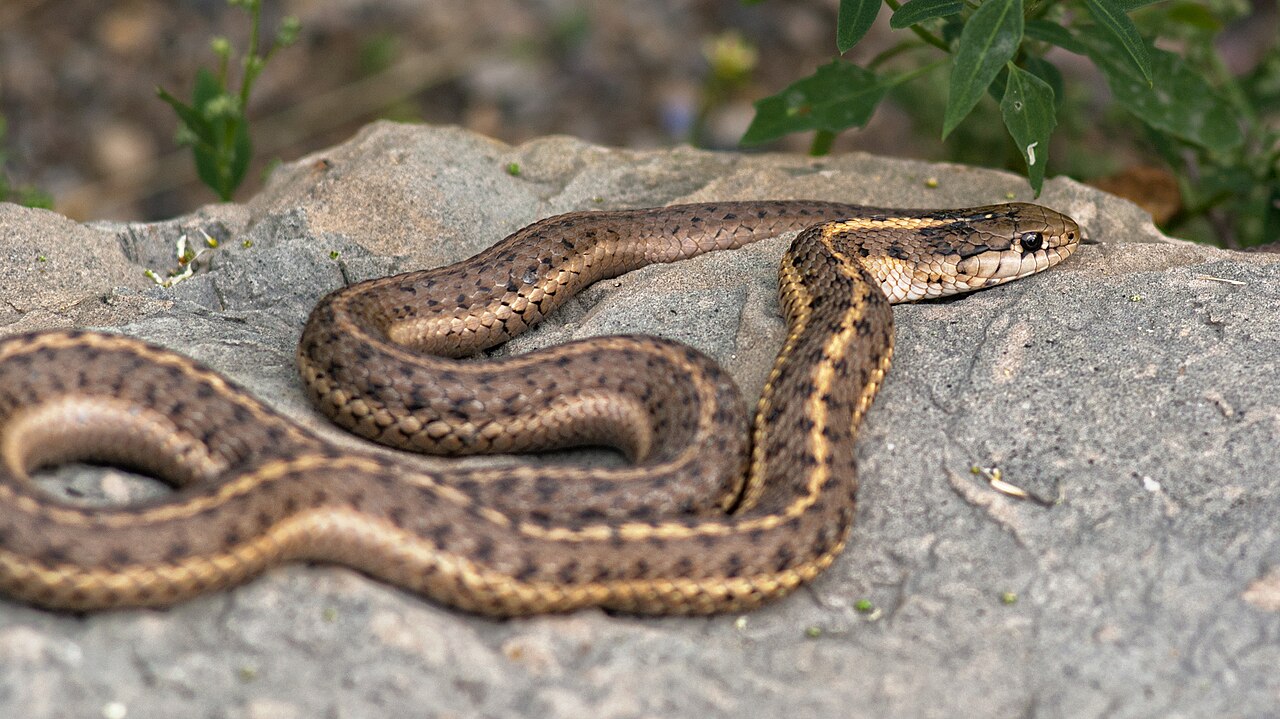
Scientific name: Genus Thamnophis
Common name: Garter snake
A common morph of the Garter snake makes it one of the most numerous black and yellow snakes.
This morph is known for black scales mixed with brown scales and a long body with a central yellow line.
The Garter snake is one of the most common snake species in certain US states. It’s the most common snake in states such as Iowa where it lives close to moist habitats.
The proximity of water sources is the place where this snake can easily be seen.
Garter snakes aren’t afraid of populated areas either. This species lives in parks and next to homes as well.
The high multiplication rates of the Garter snake are also influenced by its diet.
Common snakes of this genus are known for making the most of any food, including dead animals.
They are often seen with other types of snakes as Garter snakes overwinter with other species.
Seeing a Garter snake is possible in almost any habitat as the species is diurnal and moves around for food during the day.
2. Gopher Snake

Scientific name: Pituophis catenifer
Common name: Gopher Snake, Pacific gopher snake, Henry snake, coast gopher snake, bullsnake, Churchill’s bullsnake, Oregon bullsnake, Pacific pine snake, western bullsnake, western gopher snake, Sonoran gopher snake, western pine snake, great basin gopher snake, blow snake, and yellow gopher snake
Gopher snakes are known for being yellow. They are often confused with the Prairie rattlesnakes due to the brown blotches.
However, this species has multiple subspecies which are black and yellow.
Bullsnakes are one of the black and yellow Gopher snake subspecies.
These are some of the largest black and yellow snakes in the US since Bullsnakes measure anywhere between 4 and 6 feet as adults.
Bullsnakes aren’t venomous but they can be killed as they’re often confused with rattlesnakes.
These large snakes use constriction against small animals. Miles and small squirrels are known for being common prey for these animals.
Bullsnakes are docile and don’t readily bite people.
They prefer to stay still when seeing humans at first. It’s only when humans approach that this snake tries to appear larger or to make a quick escape.
One of the reasons why this species might be more important than first believed is its ability to kill venomous snakes.
Bullsnakes are known to resist the venom of other snake species and even to eat venomous species such as rattlesnakes.
3. Eastern Hognose Snake

Scientific name: Heterodon platyrhinos
Common name: Eastern hognose snake, spreading adder, spread’em outer, hog-nosed snake, adder, bastard rattlesnake, black adder.
The Eastern Hognose snake comes in many morphs. This snake is seen in gray, brown, or black colors with gray, black, or brown blotches.
Eastern Hognose snakes also come with a black and yellow morph. The yellow snake has black and brown blotches.
This snake is mostly known for its innate defensive abilities. It knows how to pretend to strike and it also knows how to play dead.
Eastern Hognose snakes often roll over motionless when seeing people or other predatory snakes or animals.
Eastern Hognose snakes can also pretend to bite. However, they rarely bite.
Snakes of this genus are very common in Eastern US states. They have a varied diet which includes some of the largest toads.
Female Eastern Hognose snakes are known oviparous species which means they lay eggs.
Females look for sandy soils to lay up to 25 eggs in.
You can distinguish male Eastern Hognose snakes from females by the shape of the tail. Females have a more tapered tail compared to males.
4. Speckled Kingsnake

Scientific name: Lampropeltis holbrooki
Common name: speckled kingsnake
Speckled kingsnakes are some of the most common black and yellow species in the US. This species gets its name from its small yellow or white specks on a black body.
This snake grows to a maximum size of 48 inches and it’s known for its thick body.
Snakes of this genus are common in Central and Southern US. They might be found hibernating in burrows or abandoned buildings in the winter but it’s a snake that’s very active during the summer.
Speckled kingsnakes are known as docile. They are often subject to predation, especially as juveniles.
These snakes use techniques such as shaking their tails or expelling a foul smell to keep predators away.
Speckled kingsnakes can also expel feces to deter predators.
Speckled kingsnakes are known for expanding their numbers across the US.
They are seen in multiple morphs where the yellow and black coloring is growing in numbers. Its green and black morph are also growing in numbers.
5. Texas Coralsnake
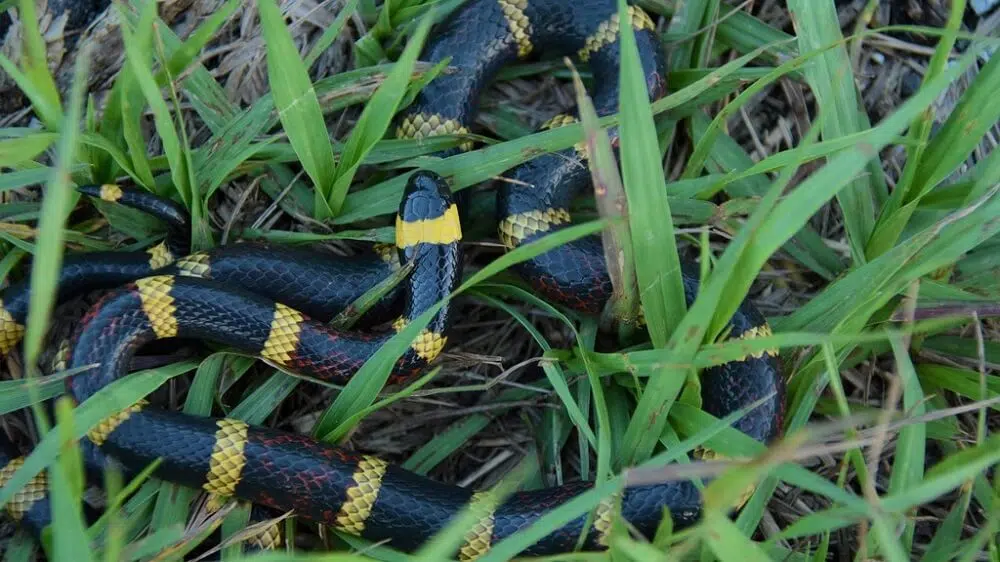
Scientific name: Micrurus tener
Common name: Texas coralsnake
Texas Coralsnakes are common in Southern states as well as in Mexico. Most colors of this snake are present in all morphs, but there are differences in nuances and the percentages of these colors about the body.
The Texas Coralsnake comes in an almost completely black morph with narrow bright yellow bands and faded red-brown blotches.
Colorful Texas Coralsnakes are known to be highly venomous. The snake has a potent venom.
This venom has a strong neurotoxin which can cause neuromuscular distinction.
High pain is associated with the bite of the Texas Coralsnakes in all of its morphs.
Known as a sub-genus of the Eastern Coralsnake, the Texas Coralsnake doesn’t have a deadly bite, or deaths from this snake’s bite haven’t been reported over the past few decades.
The coloring and the venomous nature of this snake make it a feared species in nature.
As a result, at least 2 other snake species mimic its coloring in Southern US.
6. Black Kingsnake
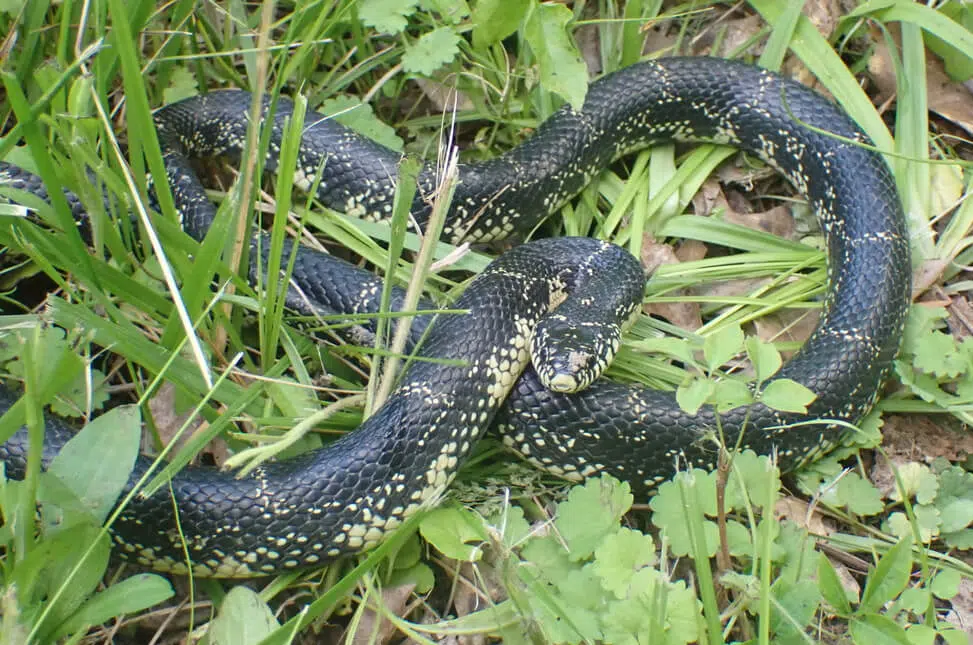
Scientific name: Lampropeltis nigra
Common name: Black kingsnake
Black Kingsnakes are almost completely black. They have a yellow underbelly being a common bicolored species in the Southern US.
This species is different from the Mexican Kingsnake due to the yellow underbelly.
Mexican Black Kingsnakes are all-black.
Black Kingsnakes live in mountains, crops, and woodlands.
The snake is a constrictor and it uses its force to suffocate various small mammals.
Since the species is medium to large (growing to 48inches) these snakes can easily overpower small rodents and similar prey.
Those seeking black and yellow snakes can find the Black Kingsnake easily as it’s the dominant species in some US states.
The Black Kingsnake is among the species that populate abandoned farmland.
It shares this habitat with other snake species but it prefers it due to the high abundance of rodents.
7. Eastern Patch-nosed Snake

Scientific name: Salvadora grahamiae
Common name: Eastern patch-nosed snake, mountain patchnose snake
The Eastern Patch-nosed snake is known for having a different scale on the snout. This snake comes in many sub-species and morphs.
Many of its sub-species are seen in black and yellow coloring.
Stripes characterize its color patterns. A green-black body with yellow stripes is characteristic of subspecies such as the Texas Patched-nosed snake or the Desert Patch-nosed snake.
8. Striped Whipsnake

Scientific name: Masticophis taeniatus
Common name: Striped whipsnake
The Striped Whipsnake grows to 72 inches. This snake species is often seen in black and yellow with hints of olive or green.
Black dorsal color is a morph of the species. Pale yellow stripes are longitudinal, specific to other striped snakes.
Common in Texas and Southern territories, the Striped Whipsnake is a species that uses its stripes and coloring to gain a camouflage advantage in its environment over other prey species.
It lives in grasslands and woodlands. The Striped Whipsnake is also seen in canyons and woodlands.
Pine-oak mixes woodlands are also a good habitat for the species.
Striped Whipsnakes are seen on rocky terrains as well. It uses rock formations to find shelter or it moves into rodent burrows for shelter.
Snakes of this genus are generalists when it comes to eating as they consume insects, frogs, and even other snakes.
Venomous snakes are sometimes eaten by the non-venomous Striped Whipsnake.
9. Western Patch-nosed Snake

Scientific name: Salvadora hexalepis
Common name: Western patch-nosed snake
The Western Patch-nosed snake gets its name from its patch-shaped scale on the nostril. It has a striped body that grows up to 3 feet.
This snake species is identified by a black body with yellow and white stripes.
Some of the white stripes are concentrated on the underbelly which can be completely white in some morphs.
Snakes of this genus like to live in desert scrublands in the Southwestern US and Mexico.
Their striped body is easily identified in these arid environments, especially since the species is diurnal.
It was believed the Western Patch-nosed snake was a constrictor, but this isn’t the case.
This species uses its body just to lay on top of prey so it doesn’t escape, but it doesn’t constrict prey.
Snakes of this genus are also very good at picking up smells since they can dig out various eggs such as snake eggs.
Agility is another attribute of the species since the Western Patch-nosed snake can climb vegetation, mostly to escape predators.
Mating happens in the summer for the species. Females lay up to 10 eggs that emerge before the summer ends.
10. Desert Kingsnake

Scientific name: Lampropeltis splendida
Common name: Desert kingsnake
Desert Kingsnakes are identified by their mostly black bodies with scarce yellow speckles.
These yellow speckles are grouped so that they form faded crossbands.
One of the different aspects of this South US species is its black abdomen. There’s no light color abdomen.
Desert Kingsnakes aren’t venomous and they’re known for their distinct coloring and large size.
They are grown in captivity where they are seen as rare exotic pet snakes and fed mice.
Snakes of this genus are very good constrictors and they know how to immobilize and kill prey before eating it.
Desert Kingsnake is also very resilient. They are shown to resist pitviper venom.
These snakes constantly eat small rattlesnakes as they can survive their venomous bites.
Desert Kingsnakes are seen laying eggs deep in sandy terrains at the beginning of the summer. Up to 12 eggs are laid at a time.
11. Lined Snake

Scientific name: Tropidoclonion lineatum
Common name: Lined snake, common snake, dwarf garter snake, grass snake, ribbon snake, streaked snake, striped snake, and swamp snake
Lined snakes are similar but less popular alternatives to Garter snakes for those planning to raise a black and yellow pet snake.
These snakes are common in Southern habitats such as Texas and are identified by a short body as they only grow to 15 inches.
Snakes of this genus have a slender body and a head that’s narrower than the body itself to help it move underground.
Lined snakes feed on earthworms and they sometimes need to dig to find them.
Snakes of this genus are often seen after rain as earthworms tend to surface at this time as well.
Otherwise, Lined snakes remain hard to find as they are a nocturnal species.
They have good vision and a good ability to sense vibrations in the ground.
Females are known to have a selective mating strategy where they can refuse to mate with certain males.
12. Eastern Foxsnake

Scientific name: Pantherophis vulpinus
Common name: Eastern foxsnake, foxsnake, fox snake
The Eastern Foxsnake is commonly seen in yellow color with black or brown blotches. This species comes in multiple other morphs and its similar size to copperheads often leads to confusion about the species.
Eastern Foxsnakes are further confused with rattlesnakes as they rattle their tails under threat.
However, Eastern Foxsnakes aren’t dangerous to people as they rarely bite and they don’t inject any venom.
These snakes are fairly docile, they have a robust body and can climb, mainly to escape predation.
People are the biggest enemy of this species as they diminish its natural grassland habitat and kill the species thinking it’s venomous.
13. Resplendent Desert Shovel-Nosed Snake
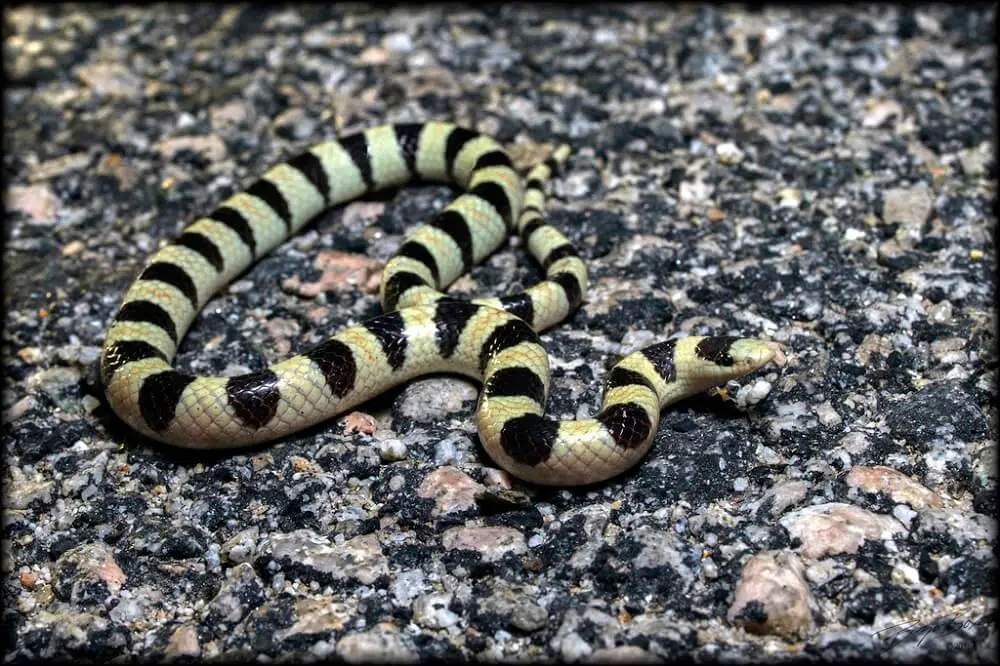
Scientific name: Chionactis annulata
Common name: Resplendent desert shovel-nosed snake
The Resplendent Desert Shove-Nosed snake is a black and yellow species most common in California, Arizona, and Baja California.
This is a slender snake with smooth scales and a short body that grows to 11 inches.
The base color of the snake is yellow. It has black bands that go around this slender body, but which cut off at the underbelly.
Adults are mostly yellow and black.
Morphs include a version of yellow, black, and red coloring. This morph also has a yellow base color and black and red bands.
Juveniles of the species are among the few black and yellow snakes that look exactly like miniature adults.
Both adults and juveniles are black and yellow.
This specie is similar to the coral snakes of the Southern US in coloring, but its’ not venomous.
While not venomous, it’s still best not to handle this snake. It can bite and its bite can inflict pain and even allergic skin reactions.
Mostly nocturnal, the snake species is rarely seen by people. It can be found when turning rocks in deserts as they like to hide in the shade during the day.
14. Mohave Shovel-Nosed Snake
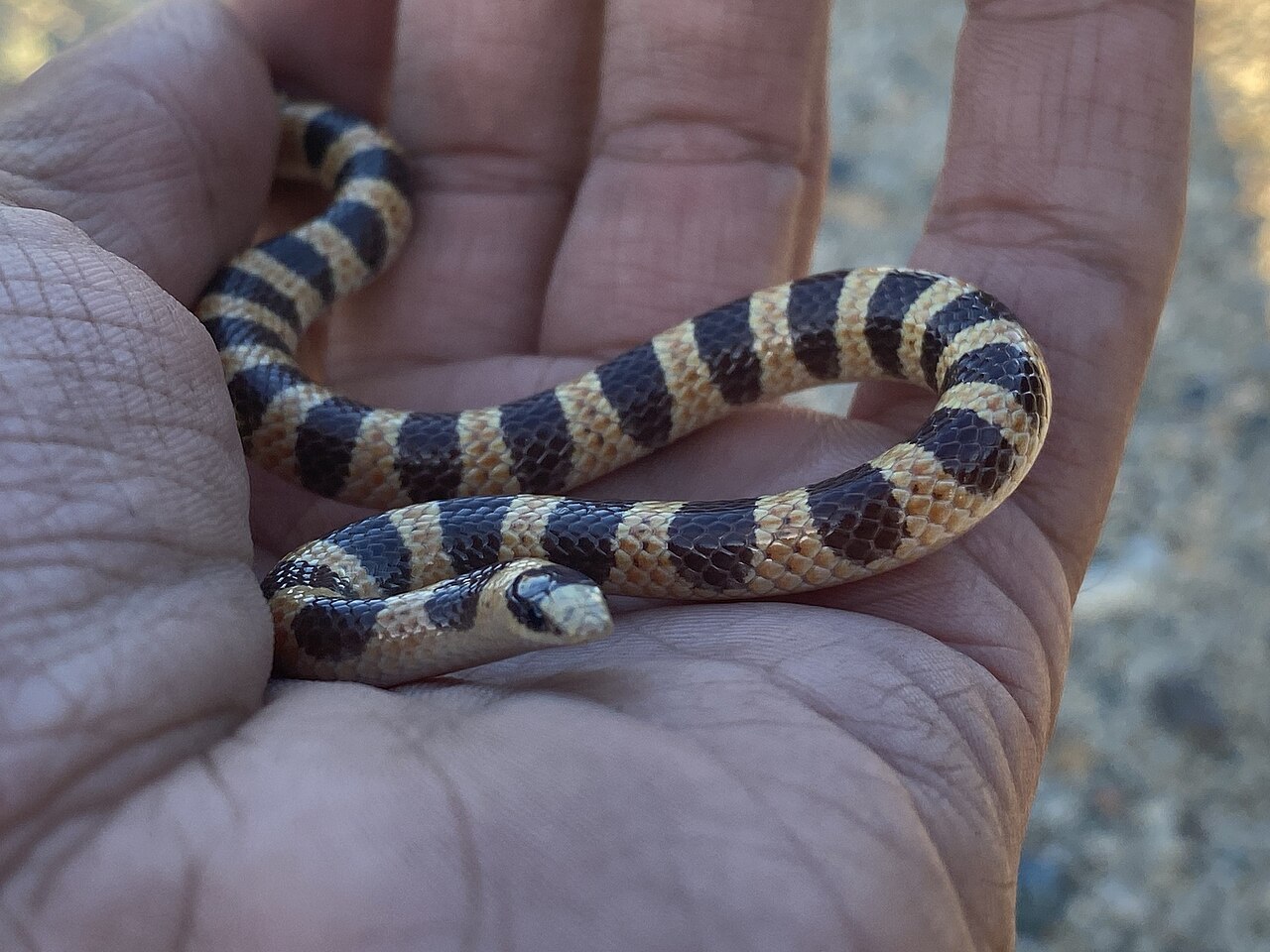
Scientific name: Chionactis occipitalis
Common name: Mohave Shovel-Nosed Snake
The Mohave Shovel-Nosed snake is only found in the Mohave region. This desert dweller is one of the main slender snake species with black and yellow coloring.
It grows to a maximum length of 17 inches and it’s mainly found in black and yellow color.
The percentage of the colors on the body is equal. Bright yellow and dark bands that run around its body are seen from head to tail.
A common morph of the specie is black with thin yellow and red rings around the body.
This species has a very thin head, often not seen as it’s not as wide as the body itself.
Snakes of the genus are nocturnal and their removed way of life makes them hard to spot.
These snakes prefer sandy terrains and rocky terrains.
Such areas of the Mojave Desert and Baja California are the home of the species.
15. Arizona Black Rattlesnake

Scientific name: Crotalus cerberus
Common name: Arizona black rattlesnake, black rattlesnake, black diamond rattlesnake, brown rattlesnake, Cerberus rattlesnake, mountain diamond-back
The Arizona Black Rattlesnakes are very difficult to correctly identify as the snake can change its color. These color alterations are mostly based on mood.
Arizona Black Rattlesnakes have a black body with large yellow scattered scales.
The species is highly venomous and potentially deadly, similar to other rattlesnakes.
Some of these snakes are also known for their high levels of aggression.
They can be found in woodlands, particularly in the more humid areas of woodlands such as underground leaves.
Snakes of this genus are also distinct by being social. They decide which group they integrate into for living together.
Relatively rare, this snake species tends to avoid confrontation. Rattling might be a first warning sign before biting.
Medical care is needed whenever this snake with its long fangs bites.
16. Common Kingsnake

Scientific name: Lampropeltis getula
Common name: Common kingsnake, eastern kingsnake, chain kingsnake, kingsnake, Carolina kingsnake, chain snake, bastard horn snake, black kingsnake, black moccasin, common chain snake, cow sucker, eastern kingsnake, horse racer.
The Common Kingsnake is seen across multiple Southeastern states. It has black and yellow coloring which depends on its region.
Some snakes of the species have more yellow speckles, mainly in the form of rings around the body while others are almost completely black.
Common Kingsnakes are very good constrictors. They eat small mammals and they can also constrict snakes, including venomous snakes.
These snakes resist the bites of other venomous species, including rattlesnakes.
Mating success is generally high in Common Kingsnakes as female leg eggs underground.
Up to 25 eggs can be laid by a Common Kingsnake female at a time.
These snakes are also known for their ferocious mating behavior as the male bites the female while mating.
17. California Kingsnake

Scientific name: Lampropeltis californiae
Common name: California kingsnake
Common in chaparral and woodlands, the California Kingsnake is one of the black and yellow species that comes in multiple other morphs.
Its morphs are mostly based on various shades of brown.
California Kingsnakes are constrictor snakes. They entangle around frogs, lizards, and mice until they suffocate them.
This species is known to reach sexual maturity by the age of 4.
Males and females are known to have similar mating habits to the Common Kingsnake. The male bites the female during the mating process.
Female California Kingsnakes lay eggs in the summer. These eggs hatch in the fall.
Up to 24 eggs can be laid at once even if females can sometimes lay just a few eggs after mating.
18. Striped Racer

Scientific name: Masticophis lateralis
Common name: Striped racer, California whipsnake
The Striped racer is one of the native Californian black and yellow snakes. It also comes in a green or gray and yellow morph.
While this species isn’t venomous to people, it’s known to be very aggressive.
Repeated bites are possible whenever handling it and it’s best left alone when seen in arid terrains, grassland, or woodland.
Also common in canyons, the snake eats insects as a juvenile turning to small mammals as an adult.
These species grow to 40 inches and it moves fast. Chances of seeing one are slim as they make a quick escape.
19. Ring-necked Snake

Scientific name: Diadophis punctatus
Common name: Ring-necked snake, ringneck snake
Ring-necked snakes are one of the most common black and yellow morph small snakes.
As their name implies, these snakes are known for having a colored ring-like marking around the neck.
This is a narrow marking that resembles a ring and that normally contrasts the main color of the snake regardless of its morph.
This can be yellow when the rest of its body is black. It can also be yellow when the underbelly of the snake is orange.
This snake is also common in gray and orange and a gray and yellow color.
Common across the Pacific Coast, these snakes can be confused with worms as juveniles.
While one of the smallest black and yellows species, Ring-necked snakes are still one of the most dangerous predators to insects, earthworms, and salamanders.
Snakes of this genus have poisonous saliva which is used against this type of prey, mainly to inhibit their movements.
20. Gold-ringed Cat Snake
Scientific name: Boiga dendrophila
Common name: gold-ringed cat snake, mangrove snake
The Golf-ringed Cat Snake is part of the Colubrid genus. This is a venomous species that are dangerous to humans.
Found in Borneo, the species is characterized by black and yellow coloring. It’s one of the few species that has deep yellow specks and not faded or pale-yellow specks.
As a Colubridae family snake, the Gold-ringed Cat snake is known for growing to a large size of up to 7 feet.
It feeds on a wide range of rodents and small animals.
While exotic-looking, the Gold-ringed Cat snake doesn’t make for the best pet. It has an aggressive and nervous nature.
Repeated strikes (some venomous and other non-venomous) are reported whenever this species is handled.
21. Saltmarsh Snake

Scientific name: Nerodia clarkii
Common name: saltmarsh snake
This snake species is found in Florida, around Tampa Bay, and close to Miami.
It prefers saltwater estuaries where it feeds and breeds.
These snakes have various morphs and they can come in a black and yellow morph. Other color combinations include red and brown or black and gray.
Snakes of this genus can be seen in late August when the female gives birth to live young.
These live young snakes measure around 7 inches reaching 30 inches as adults.
It’s believed the number of these snakes is dwelling due to a diminishing habitat, mainly for construction purposes.
People also kill some morphs of the species thinking they are venomous cottonmouths.
However, seeing one of these snakes is rare as they have adapted to nocturnal feeding.
They prefer to hide the rest of the time.
These snakes often hide in crab burrows or other mud burrows. Sandy terrains also attract them as a possibility to find an easy-to-dig burrow.
22. Yellow-Bellied Sea Snake

Scientific name: Hydrophis platurus
Common name: yellow-bellied sea snake
Yellow-Bellied Sea snakes are some of the most common snakes around the world. Their base colors are black and yellow.
These snakes have a black body with a yellow underside.
Colorful and easy to spot, they aren’t as easy to see as they live out in the sea, far from the shore.
Snakes of this genus are found almost everywhere around the world but not in the Atlantic Ocean.
They feed on a wide range of small and large fish. These snakes also eat dead fish when raised as pet snakes.
Known for being an efficient swimmer, the Yellow-Bellied Sea snake is also venomous.
It has a small amount of venom with neurotoxins and it uses it against a wide range of prey.
Some of these bites might have a fatal effect on humans. Paralysis is also a common symptom of this snake’s venomous bite.
23. Western Ribbon Snake

Scientific name: Thamnophis proximus
Common name: Western ribbon snake
The Western Ribbon snake is a black and yellow or gray and yellow species common around water sources.
Snakes of this genus are known to live long lives. They can live up to 20 years in captivity.
Western Ribbon snakes reach sexual maturity faster than other species. They are ready to reproduce within 12 months.
Amphibians are one of the preferred foods of this species.
Western Ribbon snakes are known for having unique preying techniques.
They use 3 fake strikes to drive frogs out of their hiding locations.
Frogs might be hiding in thick vegetation and the snake doesn’t know its exact location.
By mimicking 3 strikes it triggers a reaction in the frog essentially giving up its location.
24. Ribbon Snake
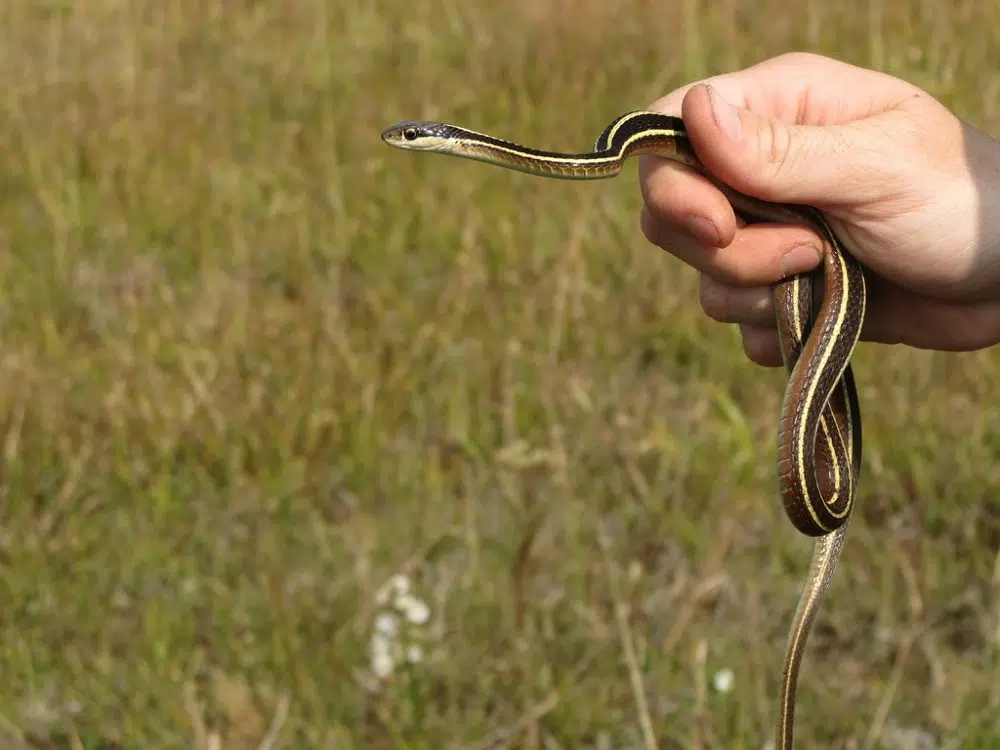
Scientific name: Thamnophis saurita
Common name: Ribbon snake
The Ribbon snake is a species native to Northeastern US territories. This species comes in a gray, olive, or black color with yellow ribbons.
It grows to a maximum size between 16 and 35 inches.
Ribbon snakes are some of the most selective predator species. They are known to have good vision, the ability to sense vibrations, and some level of auditory complexity which allows them to quickly discover prey.
Snakes of this genus feed on reptiles, newts, and salamander.
They also eat worms and spiders.
Juveniles are often subject to prey themselves, mainly by hawks and similar species.
Female ribbon snakes give birth to live young. Up to 27 young snakes can be born at once within this species.
These snakes start to live on their own soon. They eat spiders and insects to survive.
Juvenile Ribbon snakes reach maturity within 2-3 years and then start reproducing.
25. Western Black-tailed Rattlesnake

Scientific name: Crotalus molossus
Common name: Western black-tailed rattlesnake, black-tailed rattlesnake
The Western Black-tailed Rattlesnake is one of the least-poisonous rattlesnakes.
This species is found in multiple colors from black, yellow, and gray to green.
Snakes of the genus are docile. Without an aggressive nature, their venom is rarely a sign of trouble.
The venom of the Western Black-tailed Rattlesnake is hemotoxic.
It destroys red blood cells and causes the failure of internal organs.
Seeing this species is not as easy as seeing other venomous snakes since the Western Black-tailed Rattlesnake is nocturnal in the summer.
It tries to avoid the high summer heat and to look for nocturnal rodents to feed on.
It turns diurnal in the winter when it might be spotted on rocks basking in the sun.
Snakes of this genus are common in Southwestern US.
26. Yellow-bellied Liophis

Scientific name: Erythrolamprus poecilogyrus
Common name: Yellow-bellied liophis
This is a Dipsadidae family snake. It’s commonly found in South America.
Snakes of this family are common in the snake pet industry as they are multicolored. One of its most common color patterns is black and yellow.
It can have a completely yellow underbelly and a black dorsal or a black body color with yellow marks.
The species is known to be terrestrial and can swim.
It avoids confrontation with humans as it tries to flee.
Snakes of this genus are known to feed on tadpoles while young snakes of the family only feed on insects.
Much of the life and habitat of the species remains unknown as few studies have been conducted on it.
Reproductive rates are very high in captivity but there’s no confirmed data on its natural reproductive rates.
27. Chicken Snake

Scientific name: Spilotes pullatus
Common name: Chicken snake, caninana, tiger rat snake, yellow rat snake, serpiente tigre
Chicken snakes can be mostly yellow with some black scales. These snakes are identified by a flattened body from the sides, a large head, and brown to black markings on top of its head.
Its name is inspired by its ability to eat small birds. But it also eats lizards.
The snake is both diurnal and nocturnal. It prefers to live up in trees, where it can easily find small birds and their nests for eggs.
Chicken snakes can also live on the ground as long as they have food sources.
Mostly common in Central and North America, this arboreal-terrestrial species is identified by its yellow dominating coloring that stands out on trees.
Snakes of this genus are very territorial. Male Chicken snakes are known to fight for the same female, even after mating has begun.
The female is known to have the final say in the male mate. The female Chicken snake is typically followed by at least one male before mating.
28. Northern Cat-eyed Snake

Scientific name: Leptodeira septentrionalis
Common name: Northern cat-eyed snake
The Northern Cat-eyed snake is common in North and Central America.
Snakes of this species have a yellow underbelly and a brown and black dorsal.
Northern Cat-eyed snakes are known for being mildly venomous. Their venom does not kill people in small amounts.
This venom can kill smaller animals instead. The Northern Cat-eyed snake is known to kill larger frogs with its venom while it swallows smaller frogs directly.
Snakes of this family are arboreal and rarely seen. Only coming out for frogs at night, these snakes prefer to spend the day upon trees.
Up to 13 eggs are laid by the Northern Cat-eyed snake after mating. Warmer climates in Central America allow this species to lay more eggs.
These eggs hatch after 2-3 months. Warmth is believed to affect the hatching interval for the Northern Cat-eyed snake’s eggs.
29. Tiger Snake

Scientific name: Notechis scutatus
Common name: Tiger snake
Tiger snakes are some of the most common venomous species in Australia.
This snake has multiple subspecies and morphs. The Western Tiger snake has black and yellow coloring.
Snakes of this subspecies have a yellow underbelly.
Bites are often reported when it comes to Tiger snakes. While they aren’t fatal, they need medical help to treat.
Typical medical treatment is similar to the treatment of other venomous snake bites.
However, mortality rates are very high for untreated cases.
Tiger snake’s bite should be treated immediately.
Killing one of these snakes is illegal in certain countries. It’s a protected species in Australia, but not in Tasmania.
30. Snail Sucker

Scientific name: Geophis sartorii
Common name: Snail sucker
Part of the Colubridae family, the Snail sucker snake is one of the mostly black species with yellow rings around its body.
The yellow is deep and makes for a contrasting-looking snake species.
Multiple Snail sucker snakes have been discovered recently as this genus remains larger unknown.
Their preferred habitat is Central America but the most recent discoveries unearthed a group of Snail suckers in Peru.
This species has mouth adaptations that allow it to suck snails out of its shell which inspires its name.
Snakes of this tropical genus mostly live in forests.
The type of forests they inhabit influences how they look and what they eat.
Incipient research shows that the type of forests that these snakes inhabit also influences mating success.
Females living closer to the Atlantic are believed to mate with higher success.
31. Banded Krait

Scientific name: Bungarus fasciatus
Common name: Banded krait
Banded Kraits live in Southern Asia. These snakes are common in Thailand, Cambodia, and other neighboring countries.
They have only one morph with black and yellow crossbands and a black and yellow head.
Branded Kraits are highly secretive as nocturnal species that live out in grassland and forests away from inhabited areas.
They are known for eating other snakes and fish.
Banded Kraits are some of the most venomous black and yellow snakes in the world. These snakes have a high amount of neurotoxins in their venom and can kill people if sufficient venom is injected with a bite.
It’s believed an inability to breathe is the main cause of death whenever it bites people with a large amount of venom.
Bites with a smaller amount of venom are more frequent. However, even these bites come with symptoms such as stomach cramps and nausea.
It’s believed immediate medical attention is required for those bitten by this snake.
An untreated bite can lead to a human death within 24 hours.
This snake has been known to kill people handling it and its best to be avoided.
32. Military Ground Snake

Scientific name: Erythrolamprus miliaris
Common name: Military ground snake, common water snake
Military Ground snakes are identified by their black and yellow body. They have a black dorsal and yellow ventral coloring.
These snakes are part of the Colubridae genus and they live in South America.
They can be seen in Uruguay, Brazil, and Argentina.
Feeding preferences for these snakes are largely unknown due to conflicting research data. Most agree, however, that the Military Ground snake eats invertebrates and fish.
Living deep in the Brazilian rainforest, this species remains largely unknown to the scientific community. Mating is an important species survival process that is believed to be complex in this snake species.
Females can choose to mate or not. This is believed to influence their desire to eat as females that don’t mate can go a long time without eating.
Females are also larger than males and are believed to be selective in their mating partners.
Growing to about 20 inches, this species is believed to reach sexual maturity between 2 and 4 years.
Further Reading: